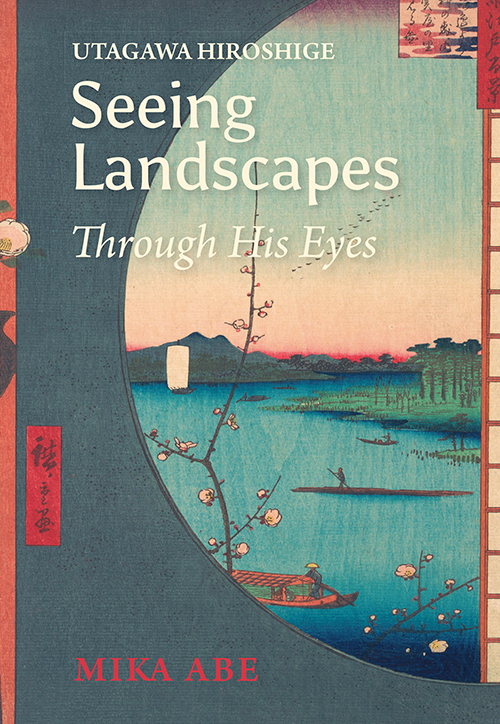
Title
Utagawa Hiroshige Seeing Landscape through his eyes
Size
264 pages
Language
English
Released
February, 2023
ISBN
9784814004850
Published by
Kyoto University Press & Trans Pacific Press
Book Info
See Book Availability at Library
Japanese Page
Landscapes are bound to change through time, shaping people’s lives differently in each successive generation. However, it is precisely through periods of change when nostalgia stirs and people hang on to the landscapes built through their upbringing and through their lives. The present day, where shifts in the sands of time are almost palpable, is also one of rapid modernisation. People grasp for points of reference in the sceneries which are fading away. In this way, the Edo period and our own are similar. Looking back to the Edo period provides a window for reflection on what landscape is, an abstract question which is fully relevant to present-day life. This book searches for the meaning of landscape through the eyes of an artist and master of landscape painting who lived, worked and wrote at that time, historical but close to our own.
This is not the first study on the scenery of Edo. In particular, there has been great scholarship on landscape represented in ukiyo prints. The topic attracts a timeless interest, inexplicably connected to the maturation of Japanese culture. This book draws on these previous studies, acutely aware of the timeless interest in Japanese culture in the closing years of Edo epoch, as it stood to face a new age of rampant modernisation. However, of greater interest here are the lessons offered by reflections on landscape for our current uncertain world. The Edo period followed a period of protracted civil war, yet the first years of Edo saw a period of frenetic construction, political upheaval and social change, even as the arts in general, and print culture in particular, flourished in the world’s most populous city. Edo rushed in fits and starts toward modernity through a maturation in the arts, civic life, and popularisation of culture. It is at these times that people are torn between the old and the new. There were some who produced art in homage to the Edo period during the following Meiji period. Those in the Heisei period, which has now just passed, may have looked back to the Showa period. For most, this nostalgia may not bite until the object of desire is fading far into the distance. Yet this nostalgia is not for artistic artefacts, but for its very foundation, the culture which generates artefacts. As such, the study of Edo landscape is crucial to find the essence of the beauty of art, and also to interpret our present. This is the starting point of a long walk through Edo with Hiroshige Utagawa – artist, visionary and landscape master. It is an effort to see through his eyes, to find a new perspective on landscape.
Hiroshige’s consciousness was mediated by prior works, but was also inspired by his cultural and artistic originality, as he saw the scenes with his own eyes. This was further moderated by the imperative for sales, to respond to his perception of the intended audience. This is not a passive process, but an active one in which Hiroshige imagined, or hypothesised, what customers might want, and incorporated such demands with his own conscious and unconscious perception of landscape. Investigating Hiroshige’s work thus requires a dual study. It requires the analysis of the common impression of famous landscapes at that time, as understood by Hiroshige. And it requires the consideration of Hiroshige’s particular perception of landscape— what scene he was attracted to and his reasons for their high esteem; and the value of his landscape perspective to understanding his later works, and its deeper meaning for us, living in the metropoles of late modernity
Though Hiroshige’s masterpiece Meisho Edo Hyakkei (One Hundred Famous Views of Edo) is more famous, and perhaps more accomplished as art, it built on earlier works. Previous studies have treated Hiroshige’s prior work Ehon Edo Miyage as a draft of his masterpiece, and as such afford its analysis a subordinate position. Whilst not in disagreement, this book considers the earlier work on its own terms, and as part of Hiroshige's journey in developing his particular perspective on landscape and more importantly as an important analytical tool to understand his later art. Unlike the masterpiece, it contains both prints and words. As such, its analysis contributes greatly to understanding Hiroshige’s particular landscape perspective.
(Written by Sam Bamkin, Assistant Professor, Center for Global Education / 2024)
Table of Contents
Part I: The Metropolis and the Artist
1. Hiroshige’s Edo: An Unprecedented Metropolis
2. Ukiyo-e Prints: A Popular Amusement in the “Floating World”
3. Hiroshige the Artist
Part II: Exploring Hiroshige’s Landscape Perspective Through His Words
4. An Analytical View of Ehon Edo Miyage
5. Ehon Edo Miyage: Genre, Content and Composition
6. “Fūkei” by Hiroshige and How Its Synonyms Are Used
7. Hiroshige’s Landscape Perspective Expressed in Written Form in Ehon Edo Miyage
8. Farmland and Countryside in Ehon Edo Miyage
Part III: Seeing Through Hiroshige’s Eyes
9. Hiroshige’s Landscape Perspective: Combining His Words and Pictures
10. Rereading a Masterpiece: Hiroshige’s Thoughts in Meisho Edo Hyakkei
Epilogue
Related Info
Introduction to School Education in Japan/Asst. Prof. Sam BAMKIN [UTokyo GUC 2025] (UTokyo Global Unit Course | YouTube Feb 13, 2025)
https://www.youtube.com/watch?v=V5Hqn7TWoKE



 Find a book
Find a book

